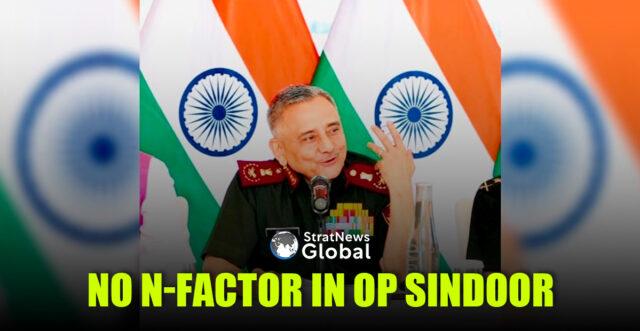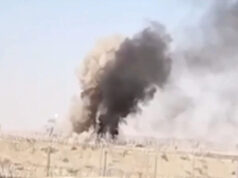India’s Chief of Defence Staff (CDS) Gen Anil Chauhan, in his first remarks after Op Sindoor, has described India’s current considered policy against Pakistan as strategic disengagement, rejecting a notion that India is amid strategic aimlessness, he said during an interaction with Singapore-based think tanks, academia and media persons on Friday.
He pointed out to the small audience that in 1947, Pakistan was ahead of India in many metrics; today, India leads in GDP, social harmony, and development. That progress reflects a long-term strategy, he added.
On the question of any possibility of a nuclear escalation between India and Pakistan, Gen Chauhan said in this context, the Indian military is seen as a rational actor. He said the nuclear escalation in undeclared wars was illogical. During the crisis, he asserted, India retained full operational clarity and autonomy, regardless of broader geopolitical currents.
Gen Chauhan described India’s four-day war as a non-contact, multi-domain conflict involving both kinetic and non-kinetic elements. It exemplifies the future of war, he said. “Modern warfare is undergoing a complex convergence—of tactics, domains (land, air, sea, cyber, space), timeframes, and strategies. This evolution demands demassified battlefields, distributed force application, non-linear operations, and a move away from large static platforms to flexible, deceptive strategies. Network-centric warfare—where integration and automation across domains are critical—is becoming the new norm,” he told the small gathering.
The CDS, in Singapore to speak at the IISS-organised Shangri La Dialogue, said in his view that the key to modern warfare lies in networking—real-time integration across air, land, sea, and cyber. Advanced technologies are only as effective as the networks to which they are connected. A strategic question we face is: Should cutting-edge tech reside in the weapon, the platform, or the network, he told the audience.
He pointed out that India’s focus on indigenous platforms, such as Akash, and self-reliant networking infrastructure has paid off. Integration of diverse radars into a unified air defence system was a key success.
On defence modernisation, Gen Chauhan shared India’s progress toward self-reliance through initiatives like Atmanirbhar Bharat. Startups, MSMEs, and major industries are increasingly involved in this quest, he added. India’s vast STEM talent—powered by institutions like the IITs—is an untapped asset that must be strategically harnessed, he said.
Interestingly, the CDS remarked that nearly 15 per cent of operational time was spent on tackling disinformation during Operation Sindoor. Underlining the need for a dedicated information warfare vertical, he said a huge amount of time was spent on countering fake news and disinformation. India’s strategy, he emphasised, was on fact-based communication, even at the cost of slower responses. Initially, two women officers served as spokespersons for the military while senior leadership was engaged in operations. Only after the stoppage of firing did three-star officers from all three services brief the media, he pointed out.
On the question of an early stoppage to war, the CDS pointed out that from an economic standpoint, prolonged mobilisation without combat imposes a significant cost. That’s why India disengages swiftly post-operations, he reminded the participants.
Prolonged wars hinder national development, something adversaries may aim to disrupt, Gen Chauhan added and said India did not want to fall into that trap.
Referring to material losses during Op Sindoor, without confirming or denying the fact, Gen Chauhan noted that no war is without costs—but what matters is how one responds. India responded effectively within three days without further escalation, he asserted. And that’s what matters, the CDS said.
Taking a deep dive into the mechanics of Op Sindoor, Gen Chauhan said Pakistan may have leveraged Chinese commercial satellite imagery, but there’s no proof of real-time targeting support. India, by contrast, relied on indigenous systems such as Akash, achieving success through effective system networking, integrating both domestic and foreign radars into a cohesive defence structure.
He revealed that cyber operations played a limited role in Op Sindoor, although there were some denial-of-service attacks and public platforms faced minor disruptions; however, operational systems remained unaffected. India’s air-gapped military systems remained secure, he added.
The CDS, however, warned that automation and robotics may be an attractive option, but reducing the human cost of war may increase the likelihood of conflict escalation. When fewer lives are at risk, decision-makers may act more aggressively, he felt. This shift presents serious ethical and strategic challenges.
Artificial Intelligence (AI) will be central to future warfare, Gen Chauhan admitted—but only if fed by relevant datasets. Currently, military AI relies mostly on open-source data, limiting its utility. It must be integrated into operations, wargaming, and intelligence gathering to become truly impactful, he added.
As CDS Gen Chauhan said, he is ushering in structural reforms in the military by addressing earlier gaps in jointness. Integrated commands and leaner, tech-oriented structures are emerging. Doctrines now include multi-domain operations, cyber, space, ISR, and joint targeting.
Nitin A. Gokhale is a media entrepreneur, one of South Asia's leading strategic affairs analyst and author of over a dozen books so far on military history, insurgencies and wars.
Starting his career in journalism in 1983, he has since led teams of journalists across media platforms.
A specialist in conflict coverage, Gokhale has covered the insurgencies in India’s North-East, the 1999 Kargil conflict and Sri Lanka’s Eelam War IV between 2006-2009.
Gokhale now travels across the globe to speak at seminars and conferences, and lecture at India’s premier defence colleges. He has founded three niche portals, Bharatshakti.in, stratnewsglobal.com and Interstellar.news.





